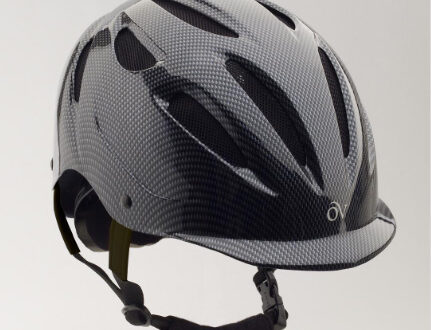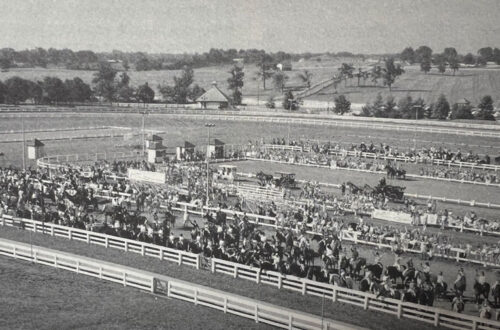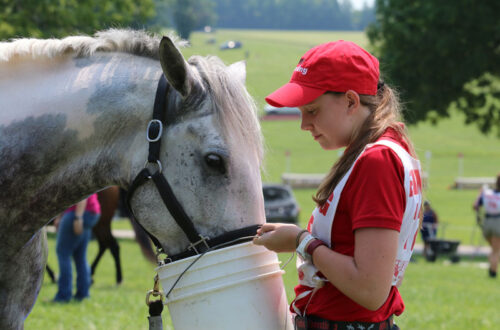
The United States Pony Clubs Adds New Helmet Certification to Official Helmet Policy; Shares Decades of Safety History
March 18, 2024 (Lexington, KY) —Since its founding, The United States Pony Clubs, Inc. (USPC or Pony Club) has led the equestrian community in promoting and teaching safe horsemanship practices in all equestrian activities. As part of its emphasis on safety, USPC has a long history of raising awareness for the usage of riding helmets, and their related safety certifications, and of working to improve safety requirements within the horse industry.
The United States Pony Clubs was the driving force behind the standardization in safety testing of riding helmets. Until recently, Pony Club was the only equestrian organization that collected data on accidents and incidents that result from horseback riding or working with horses on the ground. The USPC Safety Committee was formed for the purpose of promoting best practices in riding and working with horses and educating those involved with all Pony Club activities in the methods of incident and accident avoidance. In addition, the study of any collected data by the committee allows for Pony Club to recognize potential causes of accidents unique to horse activities and to identify possible actions that might be taken to prevent or reduce these risks.
In its commitment to continuing with the latest on safety standards, the USPC Safety Committee has added the following equestrian helmet standards to its list of acceptable helmet safety bodies: VG1 BSI Kitemark and/or IC Mark (European) and EN1384 BSI Kitemark and/or IC Mark (European).
The BSI Kitemark is a quality mark indicating that helmets are subjected to ongoing quality control by the British Standards Institute (BSI). The VG1 01.040 2014-12 is the newest standard from the European Commission. It was created according to British standards and adopted by the EU.
The European Normes EN 1384 (Helmets for Equestrian Activities) is a standard published by the Centre for European Normes in Brussels and widely used for conformity assessment in Europe. This European Standard specifies requirement for protective helmets, that may or may not have a peak, for people involved in equestrian activities.
USPC’s Official Helmet Certification Policy
With this addition, the updated USPC Policy #0810 on Safety Requirements for Helmets states:
The United States Pony Clubs, Inc. recognizes that riding is an inherently dangerous sport, and consideration for safety is of utmost importance. Participation in any equine activity can result in injury or death and individuals must assume responsibility for their own safety. In order to promote high safety standards for our members, it is the policy of the Board of Governors to require properly fitted and securely fastened helmets containing the standards and certifications that meet criteria established by specific safety bodies listed below, to be worn by members during any mounted activity (except vaulting) and during some unmounted activities.
- ASTM F1163 with SEI Mark (North America) (required for USEF Competitions)
- SNELL Memorial Foundation E2016 or E2021
- AS/NZS 3838 with SAI Global Mark (Australia and New Zealand)
- PAS 015 with BSI Kitemark (United Kingdom)
- VG1 BSI Kitemark and/or IC Mark (European)
- EN1384 BSI Kitemark and/or IC Mark (European)
Delegation of authority is to:
A. The District Commissioner (DC), Center Administrator (CA), and Regional Supervisor (RS) shall have responsibility for this policy at the local and regional levels.
B. The Vice Presidents of Instruction, Activities, and Regional Administration, as appropriate, and the National Office shall have responsibility at the national level.
C. The President and the Chair of the Safety Committee shall have oversight of this policy.
Other Guidelines on Helmets
In addition to the above policy, USPC has published in the USPC Safety Handbook: “Wearing an approved helmet every ride, every time is required.” USPC also recommends when longeing, at horse inspection (jog for soundness), and at pre-riding inspections (turnout inspection and safety checks). In addition, a detailed explanation on determining helmet fit can be found in Appendix A of the handbook.
Further guidance in the handbook includes the following tips:
To preserve the optimal function and lifespan of a helmet, avoid placing it on top of hairspray, sunscreen, or insect repellents. Clean the inside and outside of the helmet often with warm water and a mild detergent. Do not soak any part of the helmet, put it close to high heat, or use strong cleaners. Helmets should be stored in a room that does not get too hot or too cold and where it is away from direct sunlight. (Do not store an equestrian helmet in a car.)
It is important to check helmets for damage and not allow a rider to use a cracked or broken helmet or a helmet that is missing any padding or parts. Replace any equestrian helmet that is damaged or has been involved in an impact from a fall. Equestrian helmets are designed to help protect the rider’s brain and head from only one serious impact. You may not be able to see the damage to the inner protective foam, but the foam materials inside the helmet will crush after an impact. That means that the foam in the helmet can’t effectively help protect the rider’s brain and head from another impact.
When is it time to replace an old or damaged helmet? The USPC Safety Handbook offers guidelines for this as well.
You can’t tell if a helmet has been damaged by looking at or even from feeling a helmet. Not all helmet damage is easily seen or felt.
- The material inside a helmet that absorbs the concussion is expanded polystyrene, which is similar to the material used to protect heavy electronics during shipping. This material may be damaged if the helmet is dropped or worn in a fall. It will be unable to effectively absorb another impact in the same area.
- Helmets showing signs of aging or damage of any kind should be replaced.
- The headliner (the soft material between the head and the hard, outer shell) may compress over time, making a helmet too loose.
- Any helmet worn in a fall should be inspected for damage by the manufacturer before further use or replaced.
- Save the helmet box and receipt. If there is suspected damage after a fall, many manufacturers will replace the helmet for a nominal fee if you have documentation.
USPC’s Dedication to Helmet Usage
Even from its earliest days, lesson procedures required inspection of helmets to “Check that the rider’s hat and footwear comply with the current official safety rules.” At the time, riding “hats” were just that—items of apparel. The traditional velvet hunt caps of the day had no safety harness or retention system to keep them in place, thus they offered no actual protective qualities.
Fast forward to the 1970s, when the USPC Board of Governors, led by Board President Rufus Wesson, established a task group to search for a source of improved riding helmets, since they were receiving reports of increasing numbers of serious head injuries to USPC members. In 1978, an Advanced-level event rider wearing an unsecured show helmet was photographed during a fall, and the photo also showed the helmet on the ground before the rider landed and was hit on the head by a falling jump rail. The front-page story was reprinted and led to calls for action from Clarke Cassidy, a board member of the United States Combined Training Association (USCTA; now the United States Eventing Association, aka USEA).
The United States Pony Clubs and USCTA sponsored a meeting in January of 1979, which was attended by equestrian sports leaders, helmet manufacturers, lawyers, doctors, insurance representatives, competition managers, engineers, bio kineticists and members of the equestrian media. From that meeting came the help of the United States Polo Association, who offered permission to use their newly completed helmet standard. Wayne State University’s National Operating Committee on Standards for Athletic Equipment (NOCSAE) football helmet standard was also offered, as was the use of the Snell Foundation’s testing lab to test existing equestrian helmets from various other countries.
As the USPC’s new Ad Hoc Safety Committee put together a draft of a standard for protective equestrian headgear, a western New York test laboratory kindly agreed to test prototype helmets and those that passed its provisions were publicly listed. Several equestrian sport governing organizations rewrote their competition rules to require the use of the listed products. This proved to be a controversial move, and it became obvious that the committee needed a more formal procedure and more research.
Groups who used the list included six breed clubs, three instructor certification groups, 13 horse sports groups, three horse industry organizations and welfare groups, one insurance and safety advocate, four youth groups, and five national/international organizations, including those from the United States, Canada, Australia, the United Kingdom, and the Fédération Equestre Internationale (aka, the International Equestrian Federation, or FEI).
The American Society for Testing and Materials (now ASTM International) hosted an exploratory meeting, and in August 1984, the first meeting was held by members of the 1979 meeting and additional component manufacturers, standards editors, consumer safety activists, and testing lab professionals.
By 1988, and six drafts later, F1163-88 was completed as an internationally recognized standard, unique in its partnership with the Safety Equipment Institute (SEI), which provided the testing certification by impartial third-party labs and a quality-control oversight program. Members of the Equestrian Protective Headgear Subcommittee also worked on a base standard for other sports helmets, called F1446. The resulting standards were developed much more quickly than F1163 since they had the advantage of being able to customize from a successful example.
As time passed, helmets have evolved. F1163 was first published in 1988. By May of 2015 (27 years later), the SEI listed 18 manufacturers of certified equestrian helmets. The list of model numbers was six pages long. By June of 2023 (35 years later), the SEI lists 21 manufacturers of certified equestrian helmets. The list of model numbers is 16 pages long.
Today, certified helmets have become the norm in sport horse disciplines and acceptance has grown. Now helmet options go way beyond basic black. It’s possible to buy helmets covered in bling to match bling browbands and bling stirrups … to customize helmets in a zillion colors or with insets of your flag, or to feature a halo look in rose gold. There are also plenty of styles with a western aesthetic available, although helmet use among western riders has been slower to catch on.
Since March is Brain Injury Awareness Month, we encourage equestrians to visit USPC’s Head Injury and Concussion Training page and the Safety Page of our website, which contains additional safety resources and a Head Injury/Concussion Training.
About The United States Pony Clubs, Inc. — The United States Pony Clubs, Inc. (USPC or Pony Club) is a 501(c)(3) nonprofit educational organization that builds the foundation of teamwork and sportsmanship through riding, mounted sports, and care of horses and ponies, while developing and enhancing leadership, confidence, responsibility, and a sense of community in its youth and adult members. USPC is proud to offer instruction and competitive opportunities in 11 competitive disciplines through hundreds of clubs and centers across the United States. USPC’s educational standards continue to be instrumental in curriculum development for schools, universities, equestrian professionals, and organizations across the United States. Many of the nation’s top equestrians, including Olympic team members, as well as successful business professionals and leaders in a variety of fields, have roots in Pony Club. For more information, please visit www.ponyclub.org.





